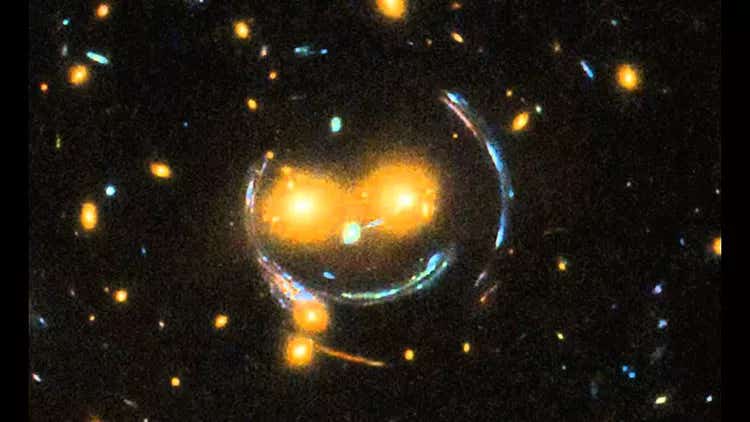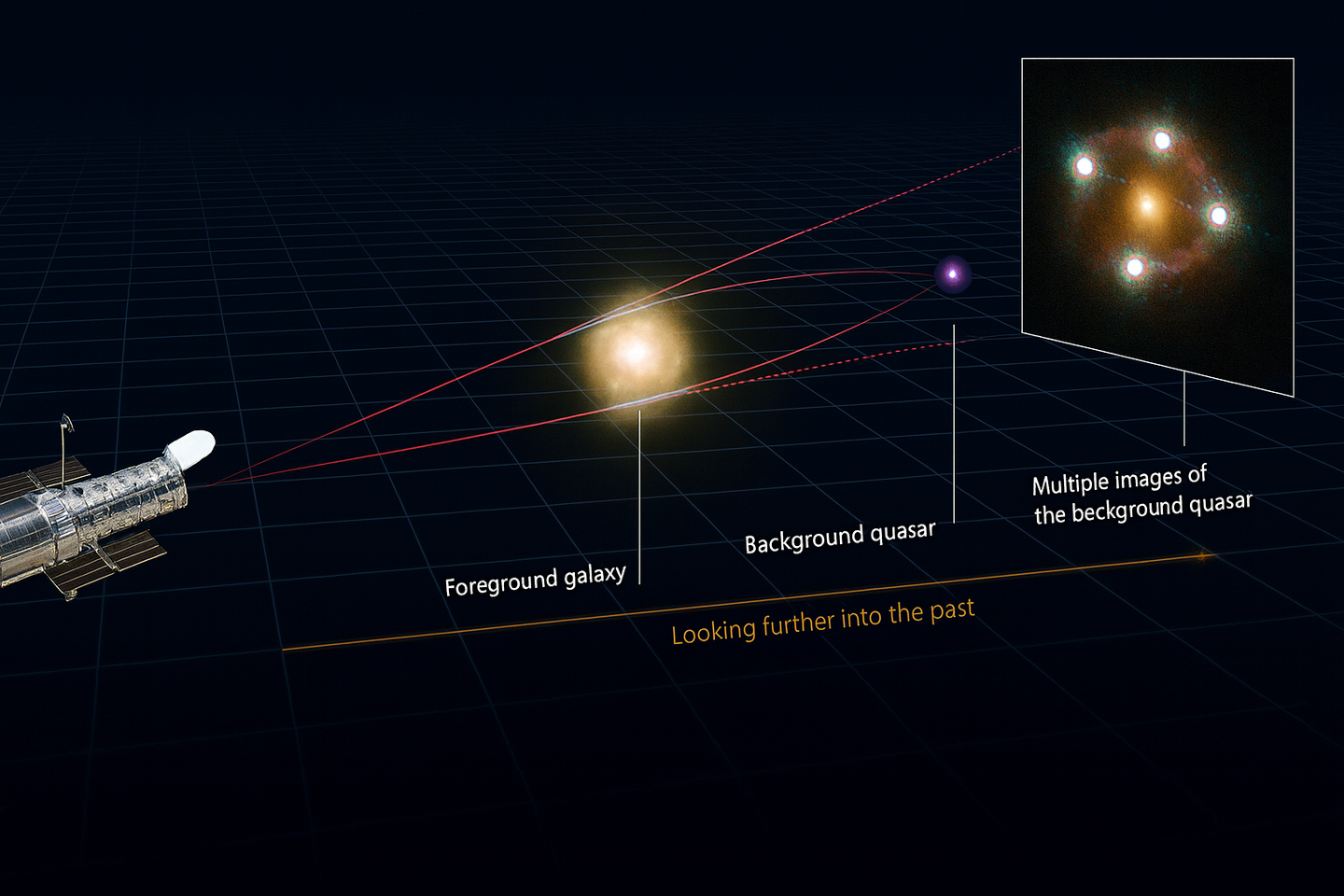Rare ‘Einstein zig-zag’ sheds light on universe’s hidden forces
One of the universe’s latest surprises—nicknamed the “Einstein zig-zag”—reveals a stunning arrangement of galaxies and a distant quasar.

The light from distant objects passed through the gravitational field of closer galaxies to create a gravitational lens that looks like a “smiley face” to the Hubble Space Telescope. (CREDIT: NASA / STScl)
The universe rarely fails to amaze. One of its latest surprises—nicknamed the “Einstein zig-zag”—reveals a stunning arrangement of galaxies and a distant quasar. Together, they produce a gravitational lens with six distinct images, something astronomers have rarely seen.
This unusual setup isn’t just a visual marvel. It’s also a powerful tool for scientists trying to crack some of the cosmos’s toughest puzzles. The Einstein zig-zag could help answer big questions, like how fast the universe is expanding and what dark energy really is.
At the heart of this system, labeled J1721+8842, lies a single quasar. Its light, originating from 11 billion light-years away, is split into six separate images. This happens because the light weaves through two galaxies that are perfectly lined up along our line of sight.
Quasars shine brightly because of the giant black holes at their centers, which feed on nearby matter. These glowing cores often serve as perfect sources for gravitational lensing. But the six-image pattern seen here is rare. Most lenses split light into two or four images. This one is different.
“This system is incredibly promising for measuring cosmological parameters,” said Martin Millon, a cosmologist at Stanford University who helped study the discovery. He and his colleagues believe this unique alignment could unlock deeper insights into how space itself stretches over time.
The quasar’s light doesn’t just bend—it zig-zags. That sharp twist through the two galaxies creates the stunning visual pattern that earned this system its nickname. It’s more than just a showpiece, though. That precise pathway gives researchers a chance to measure changes in the universe with exceptional accuracy.
What Makes Gravitational Lensing Special?
Gravitational lensing, which was predicted by Einstein’s theory of general relativity, happens when light passes near massive objects. These heavy bodies bend the fabric of space, curving the light’s route. When the alignment is just right, one object’s light can appear as multiple images. In this case, those paths came together to form a once-in-a-generation find.
Related Stories
Most gravitational lenses create two or four images of a background object. For instance, Einstein rings and Einstein crosses are common configurations formed by single galaxy lenses. However, the Einstein zig-zag represents an exceptional alignment of two galaxies lensing the light from a background quasar, resulting in six distinct images.
“Such a perfect alignment is extraordinarily rare,” said Frédéric Dux, the study’s lead author. “We estimate that one in 50,000 lensed quasars would have this configuration, and we only know of around 300 lensed quasars in total.”
The closer of the two lensing galaxies in this system is so distant that its light has been traveling for 2.3 billion years, while the second galaxy’s light has traveled for 10 billion years. Together, they form an extraordinary alignment with the quasar, which lies even farther away. This unique setup not only creates the zig-zag pattern but also enhances the scientific potential of the system.
A New Tool for Measuring the Hubble Constant
Gravitational lensing has long been a valuable tool for measuring cosmological parameters like the Hubble constant, which quantifies the rate at which the universe expands.
Traditionally, astronomers use time-delay cosmography to measure the time delays between light paths in lensed systems. These delays provide critical data about the distances involved, which are key to calculating the Hubble constant.
Collaborations such as COSMOGRAIL and H0LiCOW have achieved 2–8% precision in measuring the Hubble constant using these techniques. However, the Einstein zig-zag system offers even greater potential. Its dual-lens configuration reduces uncertainties in the calculations, providing more precise constraints on this crucial parameter.
“This system provides a unique opportunity to refine measurements of the Hubble constant,” Dux explained. “Its dual-lens structure allows for better modeling and reduced uncertainties, which is especially important given the current Hubble tension.”
The Hubble tension refers to a major discrepancy in how the Hubble constant is measured. Observations of the early universe, based on the cosmic microwave background, yield a different value than those derived from measurements of the local universe.
This inconsistency has led to a potential crisis in cosmology, prompting scientists to question the accuracy of their methods or the validity of current models.
The Einstein zig-zag could help resolve this issue by providing a more precise measurement of the Hubble constant. By reducing the uncertainty in lensing models, the system may bring the early-universe and local-universe values closer together.
“Before declaring a definite crisis, we need to refine our measurements and rule out potential errors,” Dux said. “The Einstein zig-zag offers a promising way to do that.”
Probing Dark Energy
Beyond addressing the Hubble tension, the Einstein zig-zag could also shed light on dark energy, the mysterious force driving the accelerated expansion of the universe. Dark energy accounts for roughly 70% of the universe’s total energy and matter content, yet its nature remains elusive.
The unique alignment of J1721+8842 allows scientists to simultaneously measure the Hubble constant and the equation of state of dark energy, a parameter that describes how dark energy evolves over time.
This dual measurement is typically difficult due to degeneracies in cosmological models, but the Einstein zig-zag’s configuration provides a rare opportunity to break these degeneracies.
“This system allows us to tackle two of cosmology’s biggest mysteries at once,” Dux said. “We are working on updated models to ensure that our measurements are accurate and unbiased.”
In addition to its cosmological applications, the Einstein zig-zag offers valuable insights into the properties of the lensing galaxies. The intermediate galaxy in this system not only acts as a lens but also serves as a light source, appearing as a distorted red arc in the images. This dual role enables precise measurements of its mass, star formation history, and matter distribution.
“This is the first real chance to study the clumpiness of matter and star formation in a galaxy this far away,” Dux noted. The system’s high-resolution spectrum, captured by the James Webb Space Telescope (JWST), provides detailed information about the galaxy’s composition and evolution.
The Future of Einstein Zig-Zags
Despite the JWST’s contributions, large-scale surveys are essential for discovering more systems like J1721+8842. Tools such as the Vera Rubin Observatory’s Legacy Survey of Space and Time (LSST) and the Euclid mission are better suited for identifying these rare configurations across wide swaths of the sky.
“The JWST provides incredibly detailed observations but covers only small patches of the sky,” Dux said. “For discoveries like this, we need large-scale surveys capable of scanning vast areas.”
Future surveys are expected to uncover more lensed quasars, although finding another Einstein zig-zag may be a matter of luck. Each new discovery has the potential to revolutionize our understanding of the universe, providing new data to refine models and test theories.
The Einstein zig-zag is more than a visual marvel—it is a key to understanding the universe’s most elusive forces and properties. By combining the predictive power of Einstein’s theories with cutting-edge technology, astronomers can use this rare system to address fundamental questions about dark energy, the universe’s expansion, and galaxy formation.
As astronomers continue to explore the cosmos, the Einstein zig-zag stands as a testament to the power of alignment—not just of celestial objects, but of science, technology, and curiosity. With each discovery, the universe reveals a bit more of its intricate design, inviting us to look deeper into the mysteries of space and time.
Note: Materials provided above by The Brighter Side of News. Content may be edited for style and length.
Like these kind of feel good stories? Get The Brighter Side of News' newsletter.



